Oceans Apart – Panama to Galapagos Islands

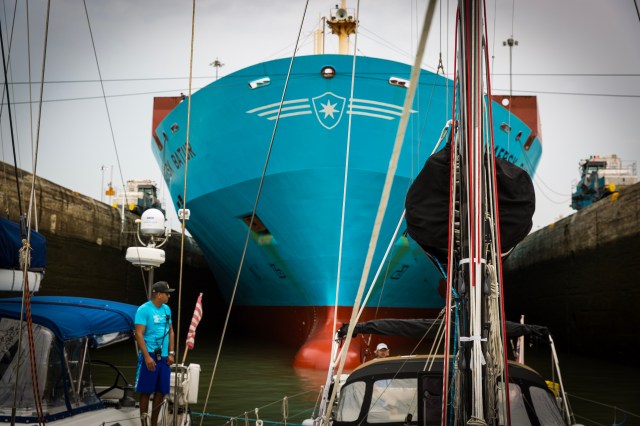
Entering a lock in the Panama Canal
The sea is still the sea no matter where you are. Its blue(ish), salty (some more than others), the wind blows, its flat, its not, its cold, its not. But it’s still the sea. So I don’t know why I was so damn excited to leave the Atlantic and get across the other side of South America to the Pacific Ocean! Home waters? A sense of achievement having made it half way home from Finland? Whatever the reason, after 9,000 nautical miles, I was ready. Very ready.
Adios Atlantic Ocean – Transiting the Panama Canal

Our official ticket to transit the canal
Leaving Shelter Bay Marina on the Atlantic side of the Panama Canal late afternoon of May 10, after being measured and inspected by the canal authorities (the boat, not me silly), with a balmy 35 degrees and dripping in humidity that runs in excess of 100%; loaded up with our 3 hired line handlers, and large orange fenders hanging off the side of Coco like, well, large orange fenders (not Coco’s best look I can assure you), was a pretty special moment.

Rafted up with two other yachts for the transit
We picked up our mandatory “advisor” from the yacht holding area a few miles from the entrance to the first lock of the canal and headed off. The advisor is like your mother, no, that’s not true, you can ignore your mother (at your peril of course), probably more like your wife. This guy makes sure you don’t do anything dumb, that you follow his instructions carefully, gets you through the process without embarrassing yourself, and is not to be disobeyed or questioned under any circumstances. Yep, very similar to a wife. Jokes aside – our guy was awesome. The advisors have done this hundreds (if not thousands) of times before, and they make the process of getting from one side of the canal to the other unscathed, almost enjoyable.

Avoiding other canal traffic!
Piggy in the Middle
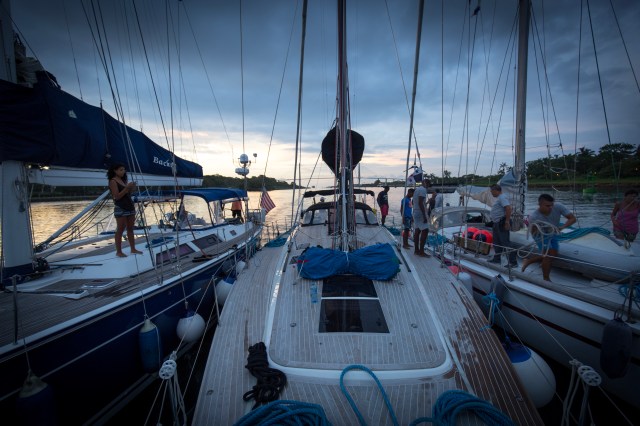
Coco playing Piggy in the Middle – rafted up for the transit
Thrown in the deep end from the start, I learnt what it means to be “the middle boat”. Had anybody told me this prior to leaving I’m not sure I would have started the transit! (mind you, I’m sure with some rudimentary research I would have worked it out for myself – knowledge is not power). With yachts, in each of the six locks, they will generally raft you up three across so they can maximize the space available in the lock and get lines attached easily from the sides to hold you steady as something like 55 million gallons of water pours into the lock in 10 minutes (now I know what that unfortunate fly who gets stuck in your toilet bowl must feel as you heartlessly hit the flush button).

Waiting in a lock for the water to drain
The middle of the three boats (me in this case) is the one that is responsible for getting all three yachts in and out of the lock without hitting the concreate wall on each side while half the world’s water is thrown at you. All this happens while a container ship, the size of a small city, sits up your arse and your helm is about as responsive as me first thing in the morning with an extra 20 tons of boat attached to each side. Let’s just say the beer after the last lock tasted pretty damn good.

Gatun Lake – Panama Canal
Putting all that aside, it’s pretty cool to be on a yacht slowly making your way across the vast manmade Gatun Lake which still has the skeletons of enormous jungle trees protruding from the calm waters (clearly the flooding of their habit didn’t agree with them), howler monkeys are abundant in the incredibly lush jungle surrounding the lake and the birdlife is amazing. The whole place is a reserve and I was surprised as to how focused they seemed to be on protecting the environment given you have container ships driving through the middle of this beautiful national park! The Smithsonian Institute has a research facility in one of the more highly protected areas where scientist’s from all over the world come and count things; lots and lots of things. So I figure if the Smithsonian is here, its gotta be cool.
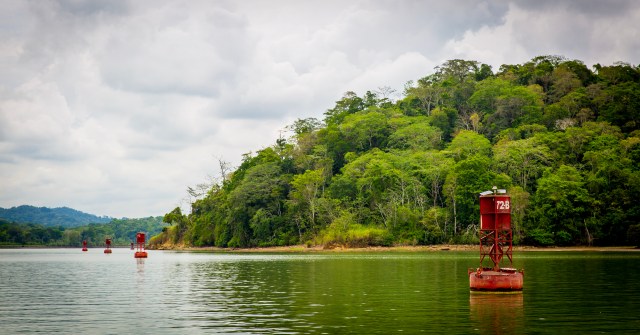
Gatun Lake – Panama Canal
Connecting the World – A Feat of Engineering and Perseverance

A huge container ship exiting a lock on the Pacific side
While to locks were a little nerve wracking (my cool calm exterior didn’t betray the inner turmoil once, I’m sure…), and the transit through the canal was a bloody awesome experience, the canal itself is a major feat in human endurance, perseverance and engineering (In saying that, I guess if you were one of the 10,000 who died in the making of said canal you might not agree – I’m not sure workplace health and safety had been invented back then). There is some incredible history surrounding the construction of the canal; the failures, the bankruptcy and bureaucracy, the nations involved, the sheer scale of what was undertaken – and the modern history with America handing it back to Panama 20 odd years ago (they seem to be very proud of the fact that “the Gringos have now gone”. Odd, no love lost there me thinks). The Panama Canal fundamentally changed trade and the transport of stuff around the world.

One of the bridges across the canal
Moving closer to the Pacific side of the canal is where the major earthworks were done. The vast workforce of thousands of poorly paid labourers; especially those with darker skin – the white dudes got paid more because, ummm, because – oh yes, because they were white! That makes perfect sense. You can tell the payroll division came from the southern states of the US of A. Sorry, I digress, where was I. These thousands of workers blasted and shovelled their way through millions of tons of rock to join the river, now lake, up with the Pacific Ocean. It’s pretty impressive what was achieved, and is still being achieved as new locks are being built for even bigger ships and higher volumes of world trade – you know, that thing where we move stuff all over the planet that we want to buy but we don’t really need creating a global economy that makes a few people lots of money and generally fucks up the environment and creates greed. Oh did that come out of my fingers? I must be getting cynical in my old age! Free trade and economies, we definitely need them. And that wall, we need that too. Alex, stay on topic, please.
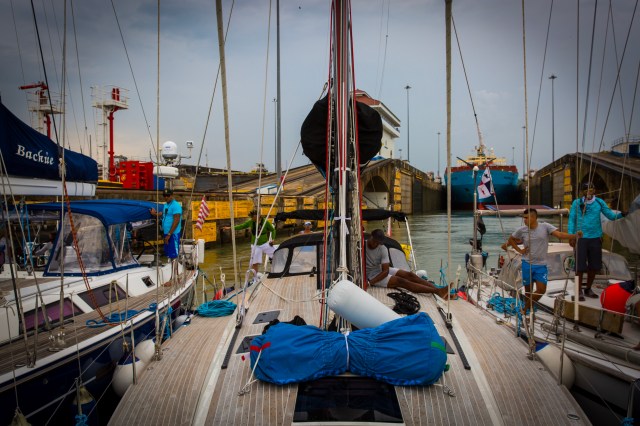
Exiting our last lock
When that final lock opened and we got our first sight of the Pacific Ocean (don’t get detailed on me, I know its technically the Gulf of Panama, but you know what I mean, there was Pacific Ocean water mixed in with it, I saw it, I promise), I did have a moment. Eight months and 9,000 miles and we are finally in our ocean. It was awesome.
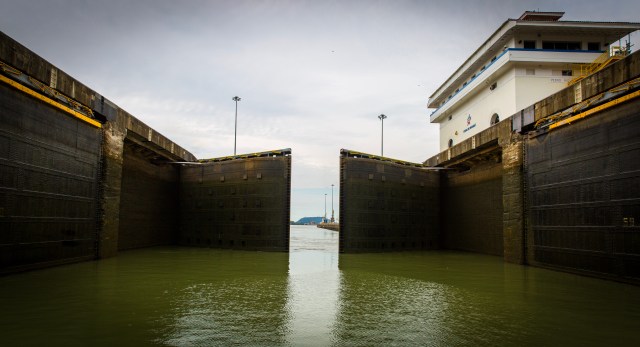
Our first glimpse of the Pacific Ocean!
Doldrums and Drug Runners – Off to the Galapagos

Awesome street-art – Panama City
We hadn’t originally planned on visiting the Galapagos Islands, we were going to sail directly to the Marquises Islands in French Polynesia as there are quite a few hoops to jump through to take your yacht into the Galapagos, and they enjoy charging for the privilege. I get it; if thousands of yachts just turn up uncontrolled in what is arguably one of the world’s top natural heritage sites covered in slim, barnacles and unidentified sea creatures from other countries, Darwin’s theory of evolution would quickly become a modern-day genetic engineering fuck-up (forever written in history as “survival of the FitBit”).
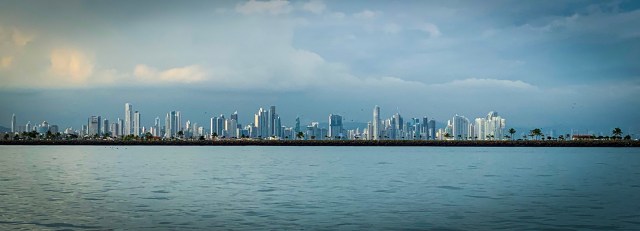
Panama City skyline
However, the weather forecast was shit. No wind out of Panama for at least two days which meant we would need to motor a good chunk at the start, which means valuable fuel used, which means we need to get more somewhere to run generators etc for our 4000 mile, month long crossing to French Polynesia. And the only place between Panama and French Polynesia to get said fuel is the Galapagos Islands, about 900 miles from Panama. You get the picture. So here we are.

A squall approaching in the Pacific Ocean
And the forecast was bang on, it was shit. We motored the first 50 hours out of Panama City, no wind to speak of and we generally spent the early hours of the morning dodging electrical storms and squalls (and logs, lots of logs). When we finally got wind on the third day we were thankful to get the engine shut down! However, the flat days were very pleasant – air temp a shade over 34 degrees, water temp 30 degrees, the dolphins, ray’s and marlin showing off with airborne antics. Perfect entertainment with the sundowner.
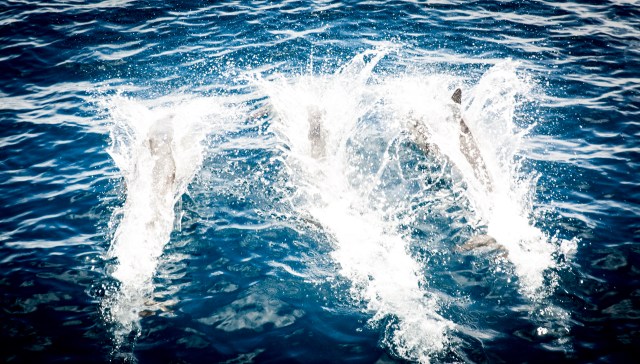
Dolphins welcoming us into our home ocean
We had a somewhat disturbing encounter with an unidentified motor boat approaching us the second night in, at speed, around midnight (no AIS, we picked them up on radar). It came within three miles off our port beam and then proceeded to shadow us for a period. When they turned their navigation lights off, I got more than a little concerned. Hmmm… I tried to hail them on the VHF for some sort of identification without any success. We made a call to go dark (AIS and navigation lights off) and we disappeared off into the night in the opposite direction which seemed to work. The whole experience was unsettling to say the least – I suspect it was a drug runner heading up the coast towards the US somewhere from Columbia and they wanted to scare us off, which they did quite successfully! (Donald, the Mexican’s aren’t your problem, I’ve seen it with my own eyes).
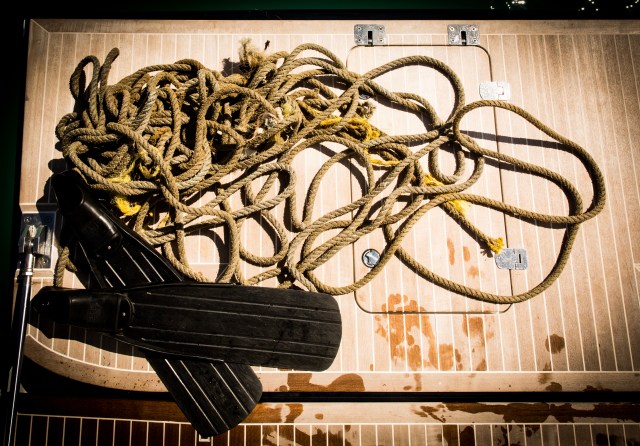
The rope that got caught around the prop at 1am
But things didn’t end there. Around 1am as we continued our retreat into the darkness, the whole yacht started shuddering. Fortunately I was right by the helm so shut the engine down immediately. A check of the engine showed nothing untoward there, however an inspection with a spotlight over the side reviled a large clump of thick rope wrapped around the rudder, and presumably the propeller. Given it was the middle of the night and the prospect of getting into 2000 metres deep of shark infested water to fumble around in the dark trying to fix the problem wasn’t that appealing, we put the Genoa up to hold us in position until daylight when I could dive the bottom of the boat and cut the rope free. Which we did, then off we went again. To add insult to injury, I was up in the boom packing the mainsail away later that morning (another failed attempt to get the sails up – still no wind), when my life-vest manual inflator got caught on a sail tie and all of a sudden I was surrounded in lifejacket! That was okay until my MOB device also deployed and hit me in the face… Some days. At least I know the life-vest works?
Evolution vs Creation – The Galapagos Islands

Hiking in the cacti – Isla Santa Cruz
I think I believe in evolution – only because yesterday, my wife told me that my feet look like those of a monkey. I’m not making that up. One thing I do know for sure, is that we are all calling the Galapagos Islands by the wrong name. They are actually called Archipielago de Colon, named after Cristobal Colon (Christopher Columbus to you English folk), but it was Charles Darwin’s visit to these 13 main islands 600 miles west of Ecuador in 1835 that really put the place on the map. He spent 5 weeks hanging out here and his observations of how the native wildlife had developed into unique species was central to his theory of evolution; and I’m sure was the reason he didn’t get invited to church that Sunday he arrived back home…

Our dive trip off Isla Santa Cruz
Early sailors, pirates, sealers and whalers didn’t really give a shit about said theory, but used the island group as a source of not only revenue from gathered beasts, but also tucker for their sea going adventures. In particular they found that the giant tortoises could be kept alive for months on end in the ship’s hold providing the crews with plenty of fresh turtle soup. So they slaughtered thousands of them (a horror I agree, and cows have the same modern day issue). So much for that theory of evolution huh. They didn’t adapt to man very well! In 1959 the islands were declared a national park and that was the end of the turtle soup. But don’t worry, you can still buy a steak on the island. It’s strange I know, but cows aren’t protected here.
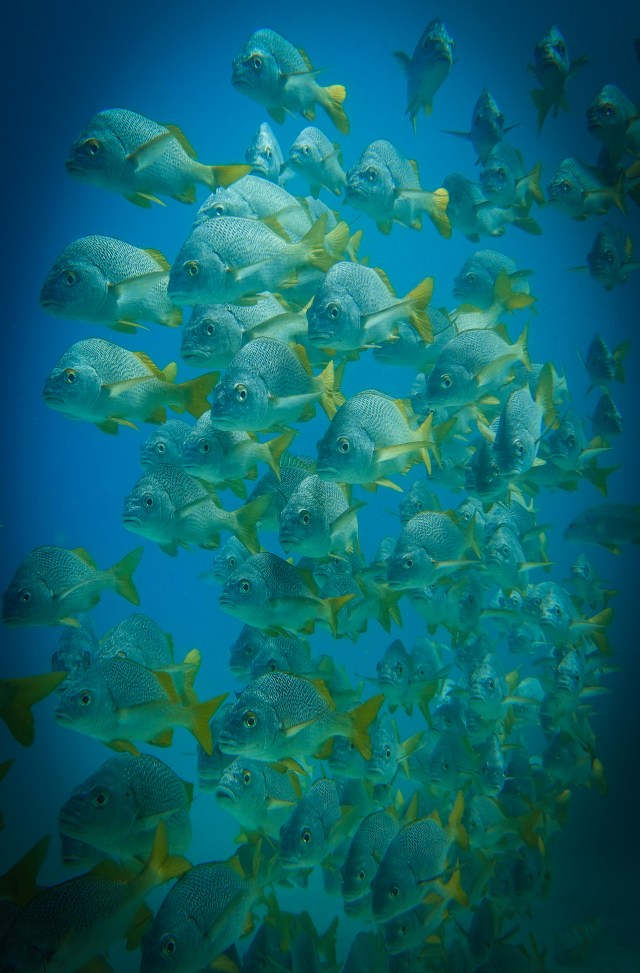
Diving Santa Cruz
These days the Galapagos receive thousands of visitors every year to ogle the birds, iguanas, sea lions, giant tortoises and incredibly rich sea life. In fact the growing number of tourists is an issue in terms protecting the place (there’s just not enough turtle soup to go around) so it’s now heavily regulated. And it’s a pig (also unprotected in the Galapagos) of a place to bring your own yacht into. The hull is inspected (if it’s not sparkly clean you are sent home), the cabin is fumigated, all your food is rummaged through (they take the real yummy stuff like mangos), and you can only get in using an official agent to help you navigate the bureaucracy. So in recent years, the number of visiting yachts has declined. But guess what, our watermaker has packed up again which is useful because we can get in at the last moment under an emergency visit to get it fixed! Finally the watermaker does something to contribute. Fucking watermaker. Lucky I have beer onboard.

Ray’s on our dive
Wild Life and Island Life
After slopping around out in the ocean for half the night waiting for first light so that we could make an elegant entry into Academy Bay, Puerto Ayora, Isla Santa Cruz, we finally arrived in the Galapagos and were besieged with customs, immigration, biosecurity, maritime safety, narcotics and entry agents. We were poked, prodded, sprayed, questioned and inspected within an inch of our lives. You’d be surprised to hear that they still let us in!

The most exciting part of the dive – 50 hammerheads!
Our first and most import job at hand was to get the watermaker attended to. I won’t bore you with the details but over a period of three days we actually managed to get the damn thing working! Just quietly, I was stoked. While we could do the 3 week passage to French Polynesia without it if we really needed to, having it working again just makes life easy.
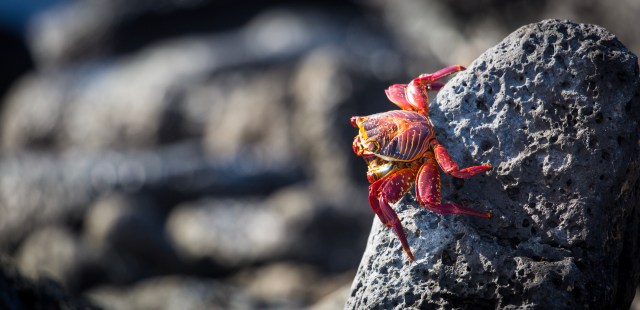
Beautiful crabs everywhere
The mundane out of the way, let’s have a look at the Galapagos. Okay, it’s touristy. There are lines of people early in the morning waiting for ferries to race them off to remote, unspoilt, connect you with Darwin’s natural wonders of the world weird and wonderful stuff. Them and a whole pile of other people! I think the way to see this place is probably to spend a lot of money getting on a high end exclusive cruise where they take you to the less visited areas. However if you do this, you better be prepared to have your safari gear along with the mandatory chin strap hat so that you fit in. Wow, tossers. National Geographic Expeditions you suck!
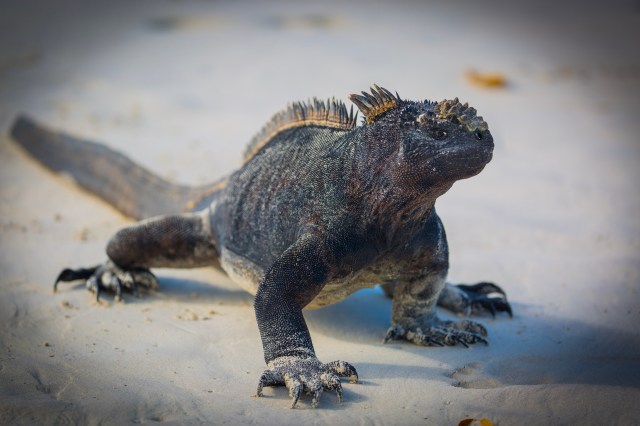
Sunbathing iguana
We ignored the tours, buses, lines of people waiting to do stuff with everyone else thing, and just headed off to see, well, stuff. I guess we did Galapagos on speed. Within a few days we’d pretty much ticked off all the major things you need to see to keep your FaceSnapGram followers happy. A hike to Tortuga Beach ticked off the Iguana’s, the fish market in Porto Ayora dealt with the environmentally friendly tuna slaughter and hungry sea lions, a quick rip up to the highlands yielded giant tortoises, and an epic day’s diving gave us hammerhead sharks!
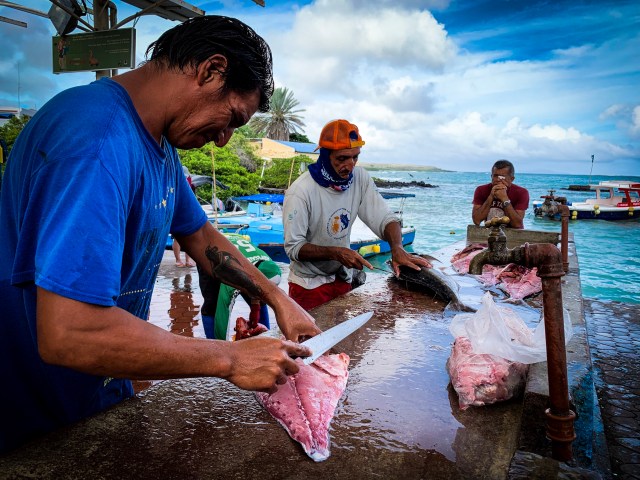
The local fish market – Puerto Ayora
Well I guess that’s about it for this leg of the journey. We’ve had some amazing experiences, seen some great stuff and met some cool people. So that’s us signing off for a bit. Next stop French Polynesia!

Big daddy – the giant tortoises of the Galapagos

Love the stories Alex. Equally happy to see you getting closer to this part of the world in one piece. Enjoy!
LikeLiked by 1 person
I’m actually quite looking forward to getting home James!
LikeLike
Awesome adventures Alex – enjoyed this latest chapter. Hope the next leg of this odyssey goes like clockwork. Love to you both xx
LikeLike
Awesome adventures Alex and I enjoyed reading the latest chapter of this odyssey. Hope the next leg goes like clockwork. Xxx to you both.
LikeLike
Pingback: Sailing from Finland to New Zealand, the final chapter. 17,500 miles, 5 oceans and 34 countries | Kiwi Travellers